Related Research Articles

The Golgi apparatus, also known as the Golgi complex, Golgi body, or simply the Golgi, is an organelle found in most eukaryotic cells. Part of the endomembrane system in the cytoplasm, it packages proteins into membrane-bound vesicles inside the cell before the vesicles are sent to their destination. It resides at the intersection of the secretory, lysosomal, and endocytic pathways. It is of particular importance in processing proteins for secretion, containing a set of glycosylation enzymes that attach various sugar monomers to proteins as the proteins move through the apparatus.

Endosomes are a collection of intracellular sorting organelles in eukaryotic cells. They are part of endocytic membrane transport pathway originating from the trans Golgi network. Molecules or ligands internalized from the plasma membrane can follow this pathway all the way to lysosomes for degradation or can be recycled back to the cell membrane in the endocytic cycle. Molecules are also transported to endosomes from the trans Golgi network and either continue to lysosomes or recycle back to the Golgi apparatus.
The Rab family of proteins is a member of the Ras superfamily of small G proteins. Approximately 70 types of Rabs have now been identified in humans. Rab proteins generally possess a GTPase fold, which consists of a six-stranded beta sheet which is flanked by five alpha helixes. Rab GTPases regulate many steps of membrane trafficking, including vesicle formation, vesicle movement along actin and tubulin networks, and membrane fusion. These processes make up the route through which cell surface proteins are trafficked from the Golgi to the plasma membrane and are recycled. Surface protein recycling returns proteins to the surface whose function involves carrying another protein or substance inside the cell, such as the transferrin receptor, or serves as a means of regulating the number of a certain type of protein molecules on the surface.

In cell biology, a phagosome is a vesicle formed around a particle engulfed by a phagocyte via phagocytosis. Professional phagocytes include macrophages, neutrophils, and dendritic cells (DCs). A phagosome is formed by the fusion of the cell membrane around a microorganism, a senescent cell or an apoptotic cell. Phagosomes have membrane-bound proteins to recruit and fuse with lysosomes to form mature phagolysosomes. The lysosomes contain hydrolytic enzymes and reactive oxygen species (ROS) which kill and digest the pathogens. Phagosomes can also form in non-professional phagocytes, but they can only engulf a smaller range of particles, and do not contain ROS. The useful materials from the digested particles are moved into the cytosol, and waste is removed by exocytosis. Phagosome formation is crucial for tissue homeostasis and both innate and adaptive host defense against pathogens.
The coatomer is a protein complex that coats membrane-bound transport vesicles. Two types of coatomers are known:
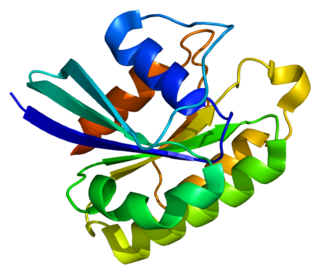
Ras-related protein Rab-5A is a protein that in humans is encoded by the RAB5A gene.

Golgin subfamily A member 2 is a protein that in humans is encoded by the GOLGA2 gene.

General vesicular transport factor p115 is a protein that in humans is encoded by the USO1 gene.

Ras-related protein Rab-1A is a protein that in humans is encoded by the RAB1A gene.
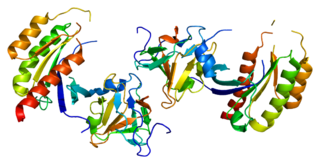
Ras-related protein Rab-8A is a protein that in humans is encoded by the RAB8A gene.

Syntaxin-5 is a protein that in humans is encoded by the STX5 gene.
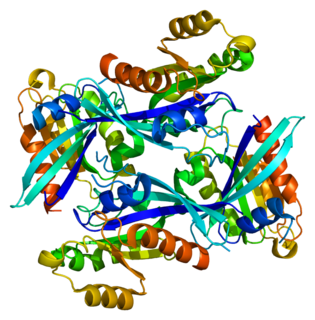
Ras-related protein Rab-2A is a protein that in humans is encoded by the RAB2A gene.

Rab GTPase-binding effector protein 1 is an enzyme that in humans is encoded by the RABEP1 gene. It belongs to rabaptin protein family.
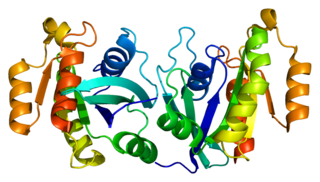
Ras-related protein Rab-11B is a protein that in humans is encoded by the RAB11B gene. Rab11b is reported as most abundantly expressed in brain, heart and testes.

Autophagy-related protein 8 (Atg8) is a ubiquitin-like protein required for the formation of autophagosomal membranes. The transient conjugation of Atg8 to the autophagosomal membrane through a ubiquitin-like conjugation system is essential for autophagy in eukaryotes. Even though there are homologues in animals, this article mainly focuses on its role in lower eukaryotes such as Saccharomyces cerevisiae.
An autophagosome is a spherical structure with double layer membranes. It is the key structure in macroautophagy, the intracellular degradation system for cytoplasmic contents. After formation, autophagosomes deliver cytoplasmic components to the lysosomes. The outer membrane of an autophagosome fuses with a lysosome to form an autolysosome. The lysosome's hydrolases degrade the autophagosome-delivered contents and its inner membrane.
Microautophagy is one of the three common forms of autophagic pathway, but unlike macroautophagy and chaperone-mediated autophagy, it is mediated—in mammals by lysosomal action or in plants and fungi by vacuolar action—by direct engulfment of the cytoplasmic cargo. Cytoplasmic material is trapped in the lysosome/vacuole by a random process of membrane invagination.

The SNX8 is a sorting nexin protein involved in intracellular molecular traffic from the early endosomes to the TGN. It is suggested that it acts as an adaptor protein in events related to immune response and cholesterol regulation, for example. As a protein of the SNXs family, the SNX8 is formed of 465 aminoacids and presents a BAR-domain and a PX-domain which are very relevant in relation to its functions. Furthermore, SNX8 study is motivated by its medical significance in relation to diseases such as Alzheimer's Disease, cancer, neurodevelopmental malformations and to its role in fighting against viral infections.
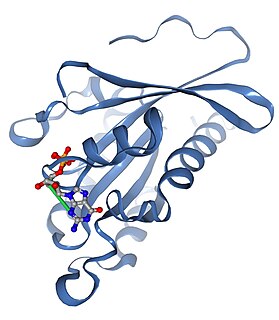
Ras-related protein Rab-2B is a protein that in humans is encoded by the RAB2B gene.
References
- ↑ Mizuno-Yamasaki, Emi; Rivera-Molina, Felix; Novick, Peter (7 July 2012). "GTPase Networks in Membrane Traffic". Annual Review of Biochemistry. 81 (1): 637–659. doi:10.1146/annurev-biochem-052810-093700. PMC 3708692 . PMID 22463690.
- ↑ Barrowman, Jemima; Bhandari, Deepali; Reinisch, Karin; Ferro-Novick, Susan (November 2010). "TRAPP complexes in membrane traffic: convergence through a common Rab". Nature Reviews Molecular Cell Biology. 11 (11): 759–763. doi:10.1038/nrm2999. PMID 20966969. S2CID 20099084.
- ↑ Wang, J.; Menon, S.; Yamasaki, A.; Chou, H.-T.; Walz, T.; Jiang, Y.; Ferro-Novick, S. (28 May 2013). "Ypt1 recruits the Atg1 kinase to the preautophagosomal structure". Proceedings of the National Academy of Sciences. 110 (24): 9800–9805. doi: 10.1073/pnas.1302337110 . PMC 3683756 . PMID 23716696.